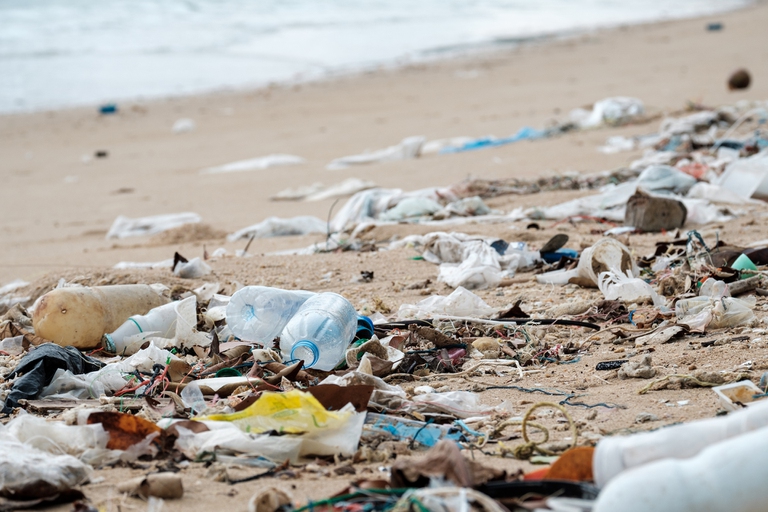Not the bees! 🐝 https://t.co/mJtWVYoZwW
— Plastic Pollutes (@PlasticPollutes) May 25, 2021

Sharon Lavigne, one of the six winners of the 2021 Goldman Environmental Prize, is fighting to protect her community from plastics corporations.
Plastic pollution is airborne too. Microplastics are being carried across continents by the wind, as a recent study reveals.
The presence of microplastics in the world’s oceans is an issue that has gained increasing attention since 2004, when the term was coined by Richard Thompson, director of the University of Plymouth’s Marine Institute in the UK. But marine environments aren’t the only habitats in which microscopic plastic fragments circulate, as these are also found in the air and terrestrial ecosystems.
A new study conducted by scientists from Cornell University and Utah State University in the United States shows that microplastics are being carried via air just like chemical elements such as calcium, carbon, hydrogen and oxygen, which cycle across the Earth via what are known as global biogeochemical cycles. This phenomenon is leading to airborne plastic pollution, a cause for concern as the accumulation of plastics in the atmosphere may have adverse impacts on human health.
The US-based National Oceanic and Atmospheric Administration (NOAA) and the European Chemicals Agency (ECHA) define microplastics as pieces of plastic less than 5 millimetres long. These fragments are classified into primary and secondary types.
Microbeads, small pieces of plastic employed as exfoliating agents in personal care products, and other purposely manufactured microplastics belong to the first category. Microplastics that derive from the breakdown of larger pieces of plastic waste are instead defined as secondary microplastics, whose release is caused by the composition of plastic itself combined with waste mismanagement.
Conventional modern plastic is derived from fossil fuel-based chemicals and as such, it degrades slowly, allowing its remnants to linger for up to hundreds of years. With a yearly plastic production of 400 million tonnes and recycling rate of about 9 per cent worldwide, a significant amount of microplastics builds up on our planet every year.
The team behind the airborne microplastic research published in the journal Proceedings of the National Academy of Sciences used more than 300 samples of airborne microplastics collected over 14 months from 11 sites across the western United States. Its goal was to elaborate a model of airborne plastic pollution and find the most likely sources of atmospheric plastic.
The researchers estimate that every year around 22,000 tonnes of microplastics are being deposited over the US, where atmospheric microplastics come primarily from secondary re-emission sources. Among these, 84 per cent come from road dust, the most significant source of this pollution. Oceans are estimated to be the second most significant contributor, accounting for about 10 per cent of airborne plastics in the US, while 5 per cent comes from agricultural soil dust.
The researchers’ model also shows that smaller microplastics could remain in the air for up to six and a half days. Under the right conditions, this is enough time for atmospheric currents to transport them across continents, causing microplastics to build up even in unexpected regions with no direct sources of plastic, such as Antarctica.
As plastic production is increasing at a rate of around 4 per cent per year, this study highlights the need to better understand the consequences of airborne microplastics for the sake of ecosystems and human health as well as the urgency of creating more efficient plastic waste management systems.
Siamo anche su WhatsApp. Segui il canale ufficiale LifeGate per restare aggiornata, aggiornato sulle ultime notizie e sulle nostre attività.
![]()
Quest'opera è distribuita con Licenza Creative Commons Attribuzione - Non commerciale - Non opere derivate 4.0 Internazionale.
Sharon Lavigne, one of the six winners of the 2021 Goldman Environmental Prize, is fighting to protect her community from plastics corporations.
Levels of particulates in New Delhi in 2020 were once again far above safety thresholds, with extremely serious health consequences for its citizens.
A major oil spill in the Ecuadorian Amazon in April has left the Coca River polluted. The indigenous Kichwa are suing the companies whose pipelines broke.
Molecules that eat up plastic waste, including PET bottles, may soon become widely used as scientists leap ahead in developing new super enzymes.
In Italy’s Land of Fires between Naples and Caserta, activists like Carmen Medaglia are fighting to promote new ways of managing waste.
Toxic substances in Kamchatka’s waters have killed 95% of marine fauna and caused health problems for surfers. The causes, however, are still unknown.
A Magellanic penguin was found lifeless on a Brazilian beach: in its stomach, an N95 face mask. Researchers believe the animal died from ingesting it.
The drop in air pollution during worldwide lockdowns helped prevent thousands of premature deaths. But the situation is returning to pre-crisis levels.
Dozens of people who fell ill because of toxic fumes and waste from a lead refinery on the outskirts of Mombasa have found justice in court.










